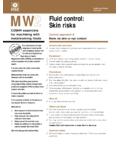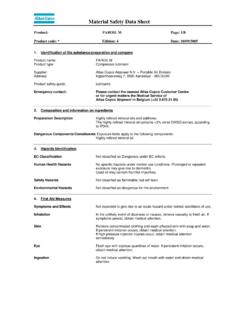Transcription of Health and Safety MW00 Advice for managers
1 Health and Safety Executive Advice for managers MW0 0 COSHH essentials for machining with metalworking fluids This information will help managers of workshops using metalworking fluids in all types of machine comply with the Control of Substances Hazardous to Health Regulations 2002 (COSHH), as amended. It is also useful for trade union Safety representatives. metalworking fluids (MWFs) are used during the machining and shaping of metals to provide lubrication and cooling. They are sometimes referred to as suds, coolants, slurry or soap. This sheet describes good practice for preventing skin disease and managing controls for exposure by inhalation. See Introduction metalworking fluids (MWFs) can cause irritation and dermatitis.
2 Poorly maintained metalworking fluid systems may lead to serious lung diseases. Advice sheets in this series MW1 Mist control: Inhalation risks MW2 fluid control: Skin risks MW3 Sump cleaning: Water-mix fluids MW4 Sump cleaning: Neat oils MW5 Managing sumps and bacterial contamination Can you use alternative metalworking methods, or safer fluids and additives? Get Safety data sheets. Action Before acting, make sure this Advice really fits your situation. Following all the Advice means that you will normally comply with good practice. Read the Advice in each of the sheets you downloaded. Compare it with what you do now. You may already have the right controls in place, but are they all working properly? When were they last checked?
3 Are they always used when needed? You need to keep all controls in good working order. This means mechanical controls (eg extraction), administrative controls (eg supervision, Health surveillance and testing regimes) and operator behaviour (following instructions). Look at all aspects of the Advice . Don t pick and choose - the points work together to provide adequate control . See sheet G406 for Advice on engineering controls. Show that control is being sustained keep good records. You need to carry out Health surveillance (see sheets G402 for asthma and G403 for dermatitis). If you are in doubt, seek expert help. Remember, just because this Advice means that you have to change old working practices or spend money on new controls, that doesn t make it unsuitable!
4 Decide how best to make any changes required across the board . Machining with metalworking fluids MW0 Advice for managers If you do need expert help, log onto the British Occupational Hygiene Society (BOHS) at , the United Kingdom Lubricants Association (UKLA) at , or ask your trade union. Facilities Provide clean facilities: a washroom, showers, storage for clean and contaminated work clothing, and a refreshment area. Provide clean overalls. Information, training and supervision Tell workers about the risks of dermatitis through skin contact with fluids. Mists from metalworking fluids can cause asthma and other lung diseases, which may lead to disablement and early death. Make use of Working safely with metalworking fluids: A guide for employees Leaflet INDG365 HSE 2006 Web only version available at Train and supervise workers - you need to make sure they are doing the job in the right way, and using controls properly to reduce their exposure as low as possible.
5 Include supervisors and managers in Health and Safety training. Ask your fluid supplier for Advice on training providers. Training should include: risks of working with MWFs; how to use the controls and how to check that they are working; how to maintain and clean equipment safely; how to use and look after personal protective equipment (PPE); and what to do if something goes wrong. Train workers to watch out for tramp oil (eg oil from hydraulics, lubricants or gearboxes) leaking into MWFs. Supervision means checking workers: use the controls provided; follow the correct work method; turn up for Health surveillance; and are following the rules on personal hygiene. Contractors also need supervision.
6 Find out if they are bringing hazardous substances on site, and how they will protect your workers from them. Machining with metalworking fluids MW0 Advice for managers Environmental guidelines Releases and wastes may be regulated within the Pollution Prevention and Control (PPC) framework. You should consult your local authority or the Environment Agency. In Scotland, consult the Scottish Environment Protection Agency (SEPA). For more information, see This guidance is issued by the Health and Safety Executive. Following the guidance is not compulsory and you are free to take other action. But if you do follow the guidance you will normally be doing enough to comply with the law. Health and Safety inspectors seek to secure compliance with the law and may refer to this guidance as illustrating good practice.
7 Published by the Health and Safety Executive 04/06













